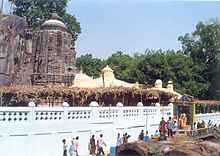
Odisha, formerly Orissa, is an Indian state located in Eastern India. It is the eighth-largest state by area, and the eleventh-largest by population, with over 41 million inhabitants. The state also has the third-largest population of Scheduled Tribes in India. It neighbours the states of Jharkhand and West Bengal to the north, Chhattisgarh to the west, and Andhra Pradesh to the south. Odisha has a coastline of 485 kilometres (301 mi) along the Bay of Bengal in the Indian Ocean. The region is also known as Utkaḷa and is mentioned by this name in India's national anthem, Jana Gana Mana. The language of Odisha is Odia, which is one of the Classical languages of India.
Bargarh is an emerging city and municipality in Bargarh district in the state of Odisha in India. It is the administrative headquarters of Bargarh District and is the 13th largest city of Odisha by population.
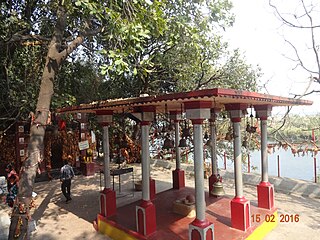
Sambalpur District is a district in the western part of state of Odisha, India. The historic city of Sambalpur is the district headquarters.

Debagarh District also known as Deogarh District is a district of Odisha state, India. Located in the north-western part of the state, it is one of the 30 administrative districts and has its headquarters at Debagarh (Deogarh) town.
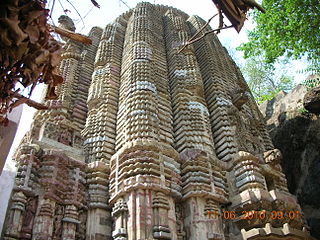
Bargarh District is an administrative district of Odisha state in eastern India. The city of Bargarh is its district headquarters. The district was carved out of the erstwhile district of Sambalpur on 1 April 1993.

Balangir also known as Bolangir, is a city and municipality, the headquarters of Balangir district in the state of Odisha, India. Balangir has one of the best cultural heritage in India. It is also known as one of the finest places for tourists in Odisha. Balangir municipality is divided into twenty-one wards. It is spread over an area of 12,200 acres (4,900 ha).
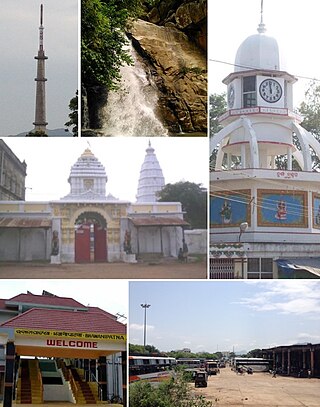
Bhawanipatna is a city and the headquarter of Kalahandi district in the state of Odisha, India. Bhawanipatna has numerous temples dedicated to different deities of the Hindu pantheon. It is named after the presiding deity, Bhawani-Shankar, and Patna, which means "place" in Odia.
Malkangiri, historically known as Malikamardhangiri, is a town and municipality in Malkangiri district in the Indian state of Odisha. It is the headquarter of the Malkangiri district. Malkangiri has been the new home of the East Bengali refugees from erstwhile East Pakistan, who have been rehabilitated since 1965 under the Dandakaranya Project. Some Sri Lankan Tamil refugees were also rehabilitated in the town, following the armed struggle of the Liberation Tigers of Tamil Eelam (LTTE) in the early 1990s, although most of them have now returned to their country. Currently, it is one of the most naxalite-affected areas of the state, and is a part of the Red Corridor.
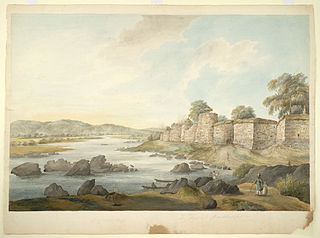
Sambalpur is the fourth largest city in the Indian State of Odisha. It is located on the banks of river Mahanadi, with a population of 335,761. Prehistoric settlements have been recorded there. It is the home of the Sambalpuri sari.

Swabhaba kabi Gangadhar Meher was an Odia poet of the 19th century. Though poor in wealth and education, he remained one of the most prolific and original contributor to Odia literature.
This article lists the traditional festivals and other cultural events in the Odisha region of India. Odisha celebrates 13 festivals in 12 months as the saying goes Bāra Māsare Tera Parba.
Western Odisha is the western part of the state of Odisha in India, extending from the Kalahandi district in the south to the Sundargarh district in the north.
Samasingha is a gram panchayat in the district of Jharsuguda in the state of Odisha in India. The block office and police station of Samasingha is Kolabira, site of the Kolabira fort. It is divided into fourteen wards. The MLA constituency is Jharsuguda and the MP constituency is Bargarh. The village is situated on the bank of the Bhede river, a tributary of the Mahanadi. Two small seasonal streams flow through the village, the larger is named Badbahal and the smaller Nalia. Bhugarapali, Junadihi, Belmunda, Jalapara/Jaladihi and Kumharmal are villages are in the neighbourhood of Samasingha. Other nearby places include Jharsuguda, Sambalpur, Kuchinda, Bamra and Bagdihi. The nearest place of tourist attraction is Gudguda. It is on the route between Sambalpur and Ranchi.

Gandhamardan Hills or Gandhamardan Parbat is a hill located in between Balangir and Bargarh district of Odisha, India. This hill is well known for medicinal plants. There is a Bauxite reserve which is planned for exploration by the state government through a private venture. Lord Parshuram is believed to reside here.
Shitalasasthi is celebrated as the wedding of Shiva and Parvati, a major festival of Utkal Brahmins and Aranyaka Brahmins since ages. It was started 400 years ago in Sambalpur after the king of Sambalpur brought Utkal Srotriya Vaidika Brahmins from Brahmin sasana villages of Puri district. The localities of Nandapada are the oldest of these Brahmins. They first started Sitalsasti Utsav. This Hindu festival is in the form of a carnival where people and artists from different walks of life participate making it more beautiful and bringing out the true colours of life. Every year it is celebrated towards the end of the summer season, the aim being to call the rain Gods to give reprieve from the scorching heat of the Sun. During the carnival period, Sambalpur attracts tourists from nearby states and abroad also.

Dr. Haldhar Nag is a Sambalpuri poet and writer from Bargarh, Odisha, India. Popularly known as "Lok Kabi Ratna". He was awarded Padma Shri, the fourth highest civilian award of India by Government of India in 2016.

Sambalpur is a district of Odisha. Sambalpur city is the headquarter of Sambalpur district. Sambalpur is the cultural capital of Western Odisha.
Jharbandh is a town in Bargarh district in the Indian state of Odisha. Jharbandh comes under the padmapur Vidhan Sabha in Odisha state and is under the Bargarh Lok Sabha constituency in India
Gopaipali is a small village under Barpali block in Bargarh District with village code 72500 as per 2001 Census.

Hirlipali is a village in Attabira Tehsil of Bargarh district of Odisha, India. The village is located on the banks of canal that flows reservoir water from Hirakud Dam. It is about 10 km from Attabira and about 20 km from Bargarh town. The total geographical area of Hirlipali Gram Panchayat is 25.19 square kilometers, and has a total population of 8,320 peoples. There are about 1,817 households in Hirlipali Gram Panchayat
